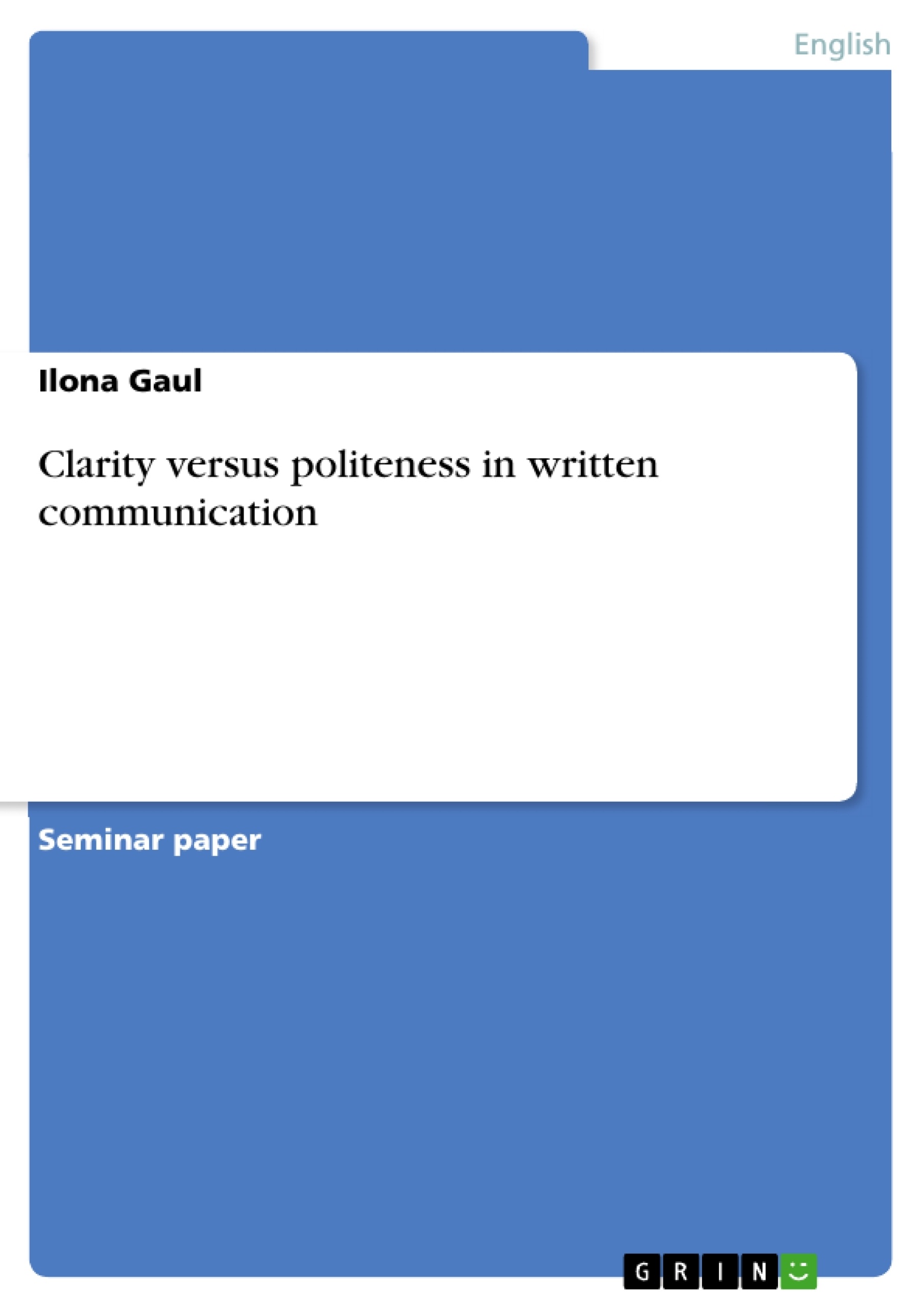The following paper seeks to be an empirical approach to the usage of clear and polite expressions in written communication. The material concerned are think- aloud-protocols, so-called TAPs, and respective letters written by students in their Hauptstudium who got the task to write to an imaginary guest professor and record their thoughts while doing this. The letters were first written in English (L2) and afterwards in German (L1) but since the main concept of politeness is very similar in these two languages and a detailed analysis of cultural differences would reach beyond the scope of this paper only the English letters are concerned here.
The students were supposed to remind the professor of correcting their termpaper early because the credit was neeeded for the registration to their final exams. Obviously, this task requires to deal with the conflict between polite behaviour and a precise presentation of facts. As it will be shown it is on the one hand often not easy to be friendly and polite when one simultaneously wants to get an important message across. On the other hand there is the danger of creating a negative impression if one exaggerates politeness. Since I am one of the students who had to write an imaginary letter and especially since I already had to write similar letters in reality and am likely to have to do it again I am really interested in the study of politeness. The close relation between theory and practice here makes the topic very attractive.
32 letters were written and afterwards ranked into a quality scale ranging from high top to deep low. From each of these categories at least one letter will be picked out for a detailed analysis. The paper is based on the theoretical background of three different models of politeness by Lakoff, Leech and Brown and Levinson which have in common that they are all linked somehow to Grice’s Cooperative Principle while Brown and Levinson’s approach seems to be the most elaborate one. The four Gricean maxims have to be adhered to in a communicative act for the sake of clarity but as it will be shown they are often violated in favour of polite speech. All of these models can be criticized more or less but since the purpose of this paper is a strong focus on the empirical part those criticisms will not be taken into consideration here.
Inhaltsverzeichnis (Table of Contents)
- Introduction
- Clarity versus Politeness
- Grice's Cooperative Principle (CP)
- Lakoff's model of Pragmatic Competence
- Leech's Politeness Principle (PP
- Brown and Levinson's model of Politeness
- Analysis of various letters
- Conclusion
- References
- Appendix
Zielsetzung und Themenschwerpunkte (Objectives and Key Themes)
This paper examines the interplay between clarity and politeness in written communication, using think-aloud-protocols and letters written by students. The study focuses on letters written in English (L2) by students tasked with writing to an imaginary guest professor, requesting a term paper correction. This task highlights the potential conflict between conveying information clearly and maintaining polite behavior.
- The relationship between clarity and politeness in written communication
- The application of politeness theories to real-world communication scenarios
- The role of Grice's Cooperative Principle in understanding politeness strategies
- The potential for conflict between clarity and politeness in conveying information
- The impact of politeness strategies on the effectiveness of communication
Zusammenfassung der Kapitel (Chapter Summaries)
The introduction sets the stage for the study by outlining the research question, methodology, and theoretical framework. The study aims to analyze the use of clear and polite expressions in written communication, utilizing think-aloud-protocols and letters written by students. The analysis focuses on English letters written to an imaginary guest professor, highlighting the conflict between clarity and politeness when requesting a term paper correction.
The chapter "Clarity versus Politeness" introduces the theoretical framework for the study, focusing on Grice's Cooperative Principle and its relationship to various politeness theories. This section explains the four maxims of the Cooperative Principle - quantity, quality, relevance, and manner - and their relevance to clear and polite communication. The chapter provides examples from the letters to illustrate how the maxims can be violated in favor of politeness.
The chapter "Analysis of various letters" delves into a detailed analysis of selected letters, applying the theoretical framework established in the previous chapter. This section examines the relationship between clarity and politeness in specific written communication scenarios, exploring the strategies employed by students to achieve both clarity and politeness in their letters.
Schlüsselwörter (Keywords)
This paper focuses on the key concepts of clarity, politeness, written communication, think-aloud-protocols, Grice's Cooperative Principle, and politeness theories. The study examines the interplay between these concepts in the context of student-written letters, analyzing the strategies employed by students to achieve both clarity and politeness in their communication.
- Quote paper
- Ilona Gaul (Author), 2006, Clarity versus politeness in written communication, Munich, GRIN Verlag, https://www.grin.com/document/54032



